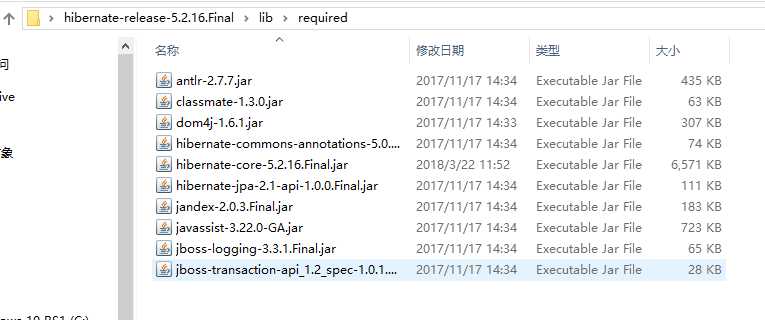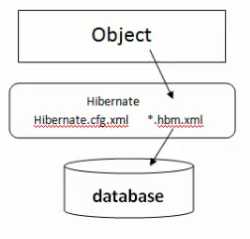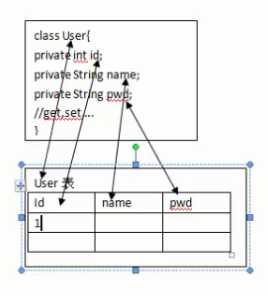Hibernate學習(1)- 初識
阿新 • • 發佈:2018-03-28
his HA logs ply func 對數 事務管理 arch 優化
一、概念引入
1、持久化:
狹義概念:數據存儲在物理介質不會丟失。
廣義概念:對數據的CRUD操作都叫做持久化。
2、加載: hibernate裏,數據從數據庫中加載到session。
3、ORM -- Object Relation Mapping

好處:
解決阻抗不匹配:對象與關系數據庫不匹配。
沒有侵入性:在代碼中不用去繼承或者實現hibernate類或實現hibernate提供的接口。
hibernate:一個ORM的輕量級框架,解決持久化問題,是程序員可以從編寫復雜的JDBC工作中解放,專註於業務,提高程序員的開發效率。
二、第一個Hibernate程序
1、資源包介紹

- documentation :相關文檔
- lib :相關的jar包
- project :相關資源文件、模板文件、源碼等
2、搭建hibernate環境
a)相關jar包 (required下的jar)


補充一點:hibernate所處的位置關系:
hibernate.cfg.xml 主要是配置信息
*.hbm.xml 實體與表的映射關系


b)添加配置文件(hibernate.cfg.xml)
<!DOCTYPE hibernate-configuration PUBLIC "-//Hibernate/Hibernate Configuration DTD 3.0//EN" "http://www.hibernate.org/dtd/hibernate-configuration-3.0.dtd"> <hibernate-configuration> <session-factory> <!-- 第一部分:數據連接配置 --> <property name="connection.driver_class">com.mysql.jdbc.Driver</property> <property name="connection.url">jdbc:mysql://localhost:3306/hibernate_test</property><property name="connection.username">json</property> <property name="connection.password">123456</property> <!-- 第二部分:其他相關配置 --> <!-- 數據庫方言 - 配置hibernate方言,可針對特定的數據庫優化。 --> <property name="dialect">org.hibernate.dialect.MySQL5Dialect</property> <!-- 是否在運行時候sql語句輸出到控制臺,編碼階段便於測試的。(默認設置為true)--> <property name="show_sql">true</property> <!-- 輸出在控制臺sql語句是否進行格式化,便於閱讀。(默認設置為true) --> <property name="format_sql">true</property> <!-- 可幫助由java代碼生成數據庫腳本,進而生成具體表結構。如:create/update/create-drop/validate create: 每次都重新建表,原來的表刪除,同時數據全部清楚重新插入數據。(每次加載hibernate,重新創建數據庫表結構,這就是導致數據庫表數據丟失的原因。) create-drop: 每次在創建sessionFactory時執行創建表,當調用sessionFactory的close方法的時候,刪除表 (在實際項目中不用) update: 只是根據映射文件去和數據庫中的表對應起來,如果不一致,就更新表的結構 validate: 加載hibernate時,驗證創建數據庫表結構,如果是不同的話則不創建表。 PS: 1.請慎重使用 hbm2ddl.auto 此參數,沒必要就不要隨便用。 2.如果發現數據庫表丟失,請檢查hibernate.hbm2ddl.auto的配置 --> <property name="hbm2ddl.auto">update</property> </session-factory> </hibernate-configuration>
c)創建數據庫
CREATE TABLE `user` ( `id` bigint(20) NOT NULL AUTO_INCREMENT, `name` varchar(255) DEFAULT NULL, `pwd` varchar(255) DEFAULT NULL, PRIMARY KEY (`id`) ) ENGINE=InnoDB DEFAULT CHARSET=utf8;
d)創建實體對象
package com.demo.pojo; public class User { private Long id; private String name; private String pwd; public Long getId() { return id; } public void setId(Long id) { this.id = id; } public String getName() { return name; } public void setName(String name) { this.name = name; } public String getPwd() { return pwd; } public void setPwd(String pwd) { this.pwd = pwd; } @Override public String toString() { return "id=" + id + ", name=" + name + ", pwd=" + pwd; } }
e)編輯*.hbm.xml文件
文件名一般為實體類User對應的名稱 User.hbm.xml
<?xml version="1.0" encoding="UTF-8"?> <!DOCTYPE hibernate-mapping PUBLIC "-//Hibernate/Hibernate Mapping DTD 3.0//EN" "http://www.hibernate.org/dtd/hibernate-mapping-3.0.dtd"> <hibernate-mapping package="org.hibernate.test.cache.infinispan.functional.entities"> <class name="com.demo.pojo.User" table="user"> <id name="id" type="java.lang.Long"> <!-- 主鍵生成策略 --> <generator class="identity"/> <!-- 自增 --> </id> <!-- 實體類屬性 --> <property name="name" type="java.lang.String"/> <property name="pwd" type="java.lang.String"/> </class> </hibernate-mapping>
f)測試
前提:將*.hml.xml文件 加入到hibernate.cfg.xml中
<!DOCTYPE hibernate-configuration PUBLIC "-//Hibernate/Hibernate Configuration DTD 3.0//EN" "http://www.hibernate.org/dtd/hibernate-configuration-3.0.dtd"> <hibernate-configuration> <session-factory> <!-- 第一部分:數據連接配置 --> <property name="connection.driver_class">com.mysql.jdbc.Driver</property> <property name="connection.url">jdbc:mysql://localhost:3306/hibernate_test</property> <property name="connection.username">json</property> <property name="connection.password">123456</property> <!-- 第二部分:其他相關配置 --> <!-- 數據庫方言 - 配置hibernate方言,可針對特定的數據庫優化。 --> <property name="dialect">org.hibernate.dialect.MySQL5Dialect</property> <!-- 是否在運行時候sql語句輸出到控制臺,編碼階段便於測試的。(默認設置為true)--> <property name="show_sql">true</property> <!-- 輸出在控制臺sql語句是否進行格式化,便於閱讀。(默認設置為true) --> <property name="format_sql">true</property> <!-- 可幫助由java代碼生成數據庫腳本,進而生成具體表結構。如:create/update/create-drop/validate create: 每次都重新建表,原來的表刪除,同時數據全部清楚重新插入數據。(每次加載hibernate,重新創建數據庫表結構,這就是導致數據庫表數據丟失的原因。) create-drop: 每次在創建sessionFactory時執行創建表,當調用sessionFactory的close方法的時候,刪除表 (在實際項目中不用) update: 只是根據映射文件去和數據庫中的表對應起來,如果不一致,就更新表的結構 validate: 加載hibernate時,驗證創建數據庫表結構,如果是不同的話則不創建表。 PS: 1.請慎重使用 hbm2ddl.auto 此參數,沒必要就不要隨便用。 2.如果發現數據庫表丟失,請檢查hibernate.hbm2ddl.auto的配置 --> <property name="hbm2ddl.auto">update</property> <!-- 第三部分:加載所有的映射(*.hbm.xml) --> <mapping resource="com/demo/pojo/User.hbm.xml"></mapping> </session-factory> </hibernate-configuration>
測試類:
package com.demo.test; import org.hibernate.Session; import org.hibernate.SessionFactory; import org.hibernate.Transaction; import org.hibernate.boot.MetadataSources; import org.hibernate.boot.registry.StandardServiceRegistry; import org.hibernate.boot.registry.StandardServiceRegistryBuilder; import org.junit.jupiter.api.Test; import com.demo.pojo.User; public class QueryTest { @Test public void connectTest() { /* //1、新建Configuration對象 (Configuration管理加載配置文件) Configuration config = new Configuration().configure(); //2、通過configuration得到SessionFactory對象 //3、通過SessionFactory得到Session對象 //hibernate3.x 中的寫法 SessionFactory session = config.buildSessionFactory(); //hibernate4.3之前 ~~ 4.0 ServiceRegistry serviceRegistry = new ServiceRegistryBuilder().applySettings(config.getProperties()).buildServiceRegistry(); SessionFactory sessionFactory = config.buildSessionFactory(serviceRegistry); Session session = sessionFactory.openSession(); //hibernate4.3 其中的一種 獲取SessionFactory的方法 ServiceRegistry serviceRegistry = new StandardServiceRegistryBuilder().applySettings(config.getProperties()).build(); SessionFactory sessionFactory = config.buildSessionFactory(serviceRegistry); Session session = sessionFactory.openSession(); */ //Hibernate5.1 的獲取SessionFactory的方法 StandardServiceRegistry serviceRegistry = new StandardServiceRegistryBuilder().configure().build(); SessionFactory sessionFactory = new MetadataSources(serviceRegistry).buildMetadata().buildSessionFactory(); Session session = sessionFactory.openSession(); //4、通過Session得到Transaction對象 (兩種寫法) //Transaction transaction = session.getTransaction(); //transaction.begin(); Transaction transaction = session.beginTransaction(); //5、保存數據 User user = new User(); user.setName("張三"); user.setPwd("123456"); session.save(user); //6、提交事務 transaction.commit(); //7、關閉Session session.close(); } @Test public void queryTest() { //Hibernate5.1 的獲取SessionFactory的方法 StandardServiceRegistry serviceRegistry = new StandardServiceRegistryBuilder().configure().build(); SessionFactory sessionFactory = new MetadataSources(serviceRegistry).buildMetadata().buildSessionFactory(); Session session = sessionFactory.openSession(); //5、保存數據 User user = session.get(User.class, 8L); System.out.println(user); //6、提交事務 //7、關閉Session session.close(); } @Test public void saveTest() { //Hibernate5.1 的獲取SessionFactory的方法 StandardServiceRegistry serviceRegistry = new StandardServiceRegistryBuilder().configure().build(); SessionFactory sessionFactory = new MetadataSources(serviceRegistry).buildMetadata().buildSessionFactory(); Session session = sessionFactory.openSession(); //4、通過Session得到Transaction對象 Transaction transaction = session.beginTransaction(); //5、保存數據 User user = new User(); user.setName("張三"); user.setPwd("123456"); session.save(user); //6、提交事務 transaction.commit(); //7、關閉Session session.close(); } }
PS:
- SessionFactroy對象: 是一個session工廠,是一個重量級的對象,在一個應用中最好也是單例的,是一個線程安全的,屬於進程級的對象。
- Session對象:使用hibernate進行數據庫操作,主要使用session。session可以理解為對connction對象的一個包裝。session對象中提供了對數據庫的CRUD操作,Session是一個線程不安全的對象,生命周期很短暫,一般和事務一一對應。Session又稱為hibernate的一級緩存。Session又是Transaction對象的工廠。
- Transaction對象:事務管理對象,通過Session獲取該對象。
- Query 對象: 條件查詢
PS:源碼地址 https://github.com/JsonShare/hibernate-demo
PS:原文地址 http://www.cnblogs.com/JsonShare/p/8647269.html
Hibernate學習(1)- 初識
